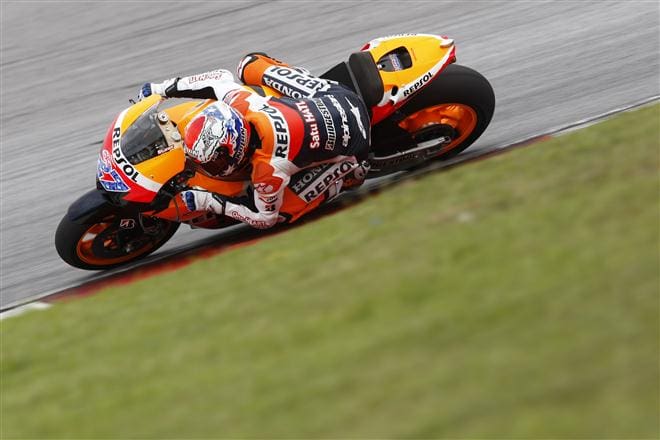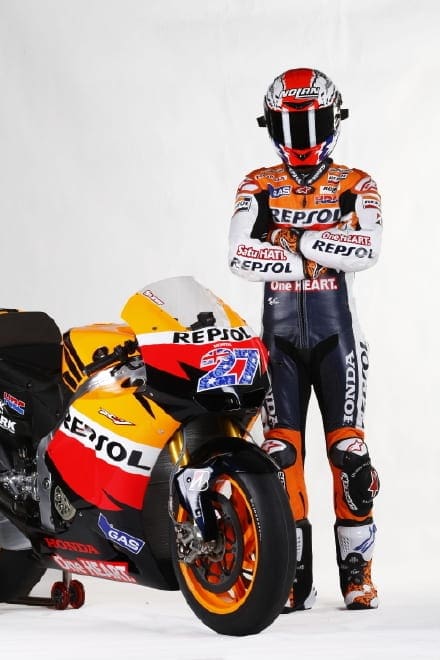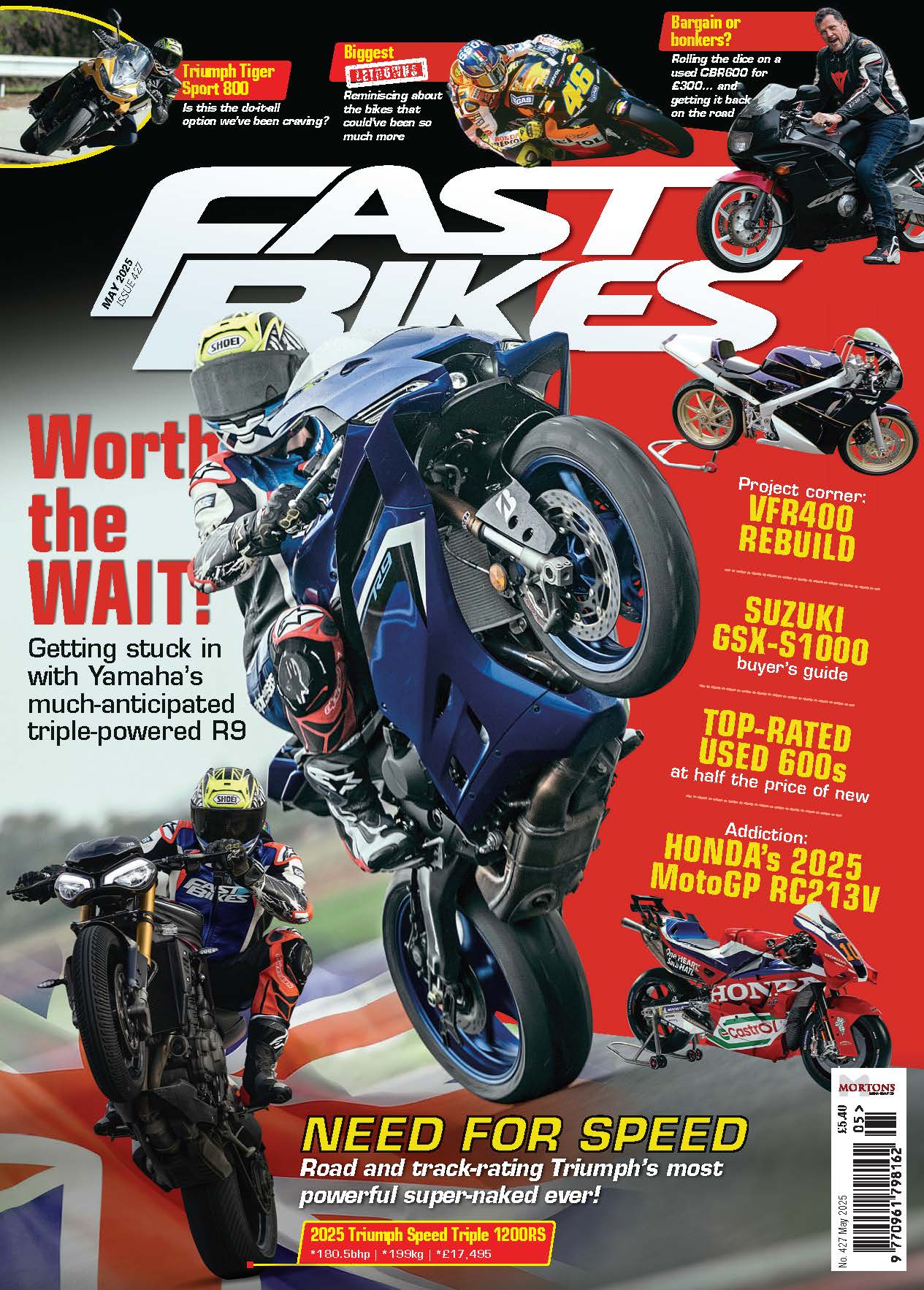Here’s a Casey Stoner interview, but seeing as it’s been done by HRC themselves, we’re not going to find out much beyond the man and his relationship with the Honda machine. Still, parts of it are interesting as it refers to the looming era of the 1000cc MotoGP bike – let’s just hope they bring back the entertainment… Read on (and note that the press release managed to spell Casey’s name wrong!)

Casey Stoner is the most successful rider of the 800cc era. Since the 800cc motors were introduced at Qatar in 2007, where Stoner celebrated his first premier class victory, through last weekend’s Italian Grand Prix at Mugello, Stoner had won 27 races. The majority came in 2007, when he collected ten race victories en route to the 2007 MotoGP World Championship.
With a brilliant start to this season, the 25-year-old Australian has continued to add to his tally. Through the first eight races Stoner has four wins, a second, and two thirds. The only time he’s failed to finish on the podium was at the Spanish Grand Prix in Jerez when he was knocked out of second place early in the race.
Stoner has been called the fastest rider by a number of his peers, including team-mate Andrea Dovizioso. His five poles in eight races bear that out. But now that the 800cc era is drawing to a close, we thought we’d get Stoner’s thoughts on the move to the 1000cc era.

Can you explain, using a specific corner, the difference in cornering technique with the Repsol Honda RC212V and next year’s machine?
It’s really hard to explain, because there’s basically no two corners in the world that are the same. So to ride them in the same way, I think, may be what sets me apart sometimes from other riders, is the fact that I’ll attack each corner the way it needs to be ridden. There’ll be different patches, different surfaces in different areas. And sometimes the ideal line won’t be the ideal line on that particular corner, so it’s adapting yourself to each part of the track, whether you can use part or you can’t. How you’ve got to get through each corner is quite difficult. At each track you go to you can’t just ride in the method that you know and you’ve actually got to ride it to the way it needs to be ridden. It sometimes can be a bit tricky. With the 1000 I think it’s going to be a little less dependent on that sort of riding, because you’re going to be able to make up a little bit of power. But at the same time, just concentrate more on getting out of the corner, rather than getting through it quite as fast. It’s still going to very dependent on getting through the corner, but I think more in getting into the corner and getting out of the corner than those lines in that particular area than we had on 800s on the way through the corner. It’ll change the way people ride a little bit.
Will it change the way the race is run?
Yes and no. I’m not really sure. I think the way 1000s were beforehand, there was still a tyre battle and there was a tyre battle for the first part of 800s, which produced some great races and passes back and forth and all the rest of it. Now with 1000s, it’s not going to be a lot of difference. I’ve ridden the 1000 again and I went from 1000 to 800 and there wasn’t huge differences. The main thing you notice is in the higher gears, fourth, fifth on the 800, you basically don’t have a lot of power to spin, so when you spin you’ve got to be on the edge of the tyre. But with the 1000 you’re still able to spin, even when you pick the bike up it’s still trying to spin a little bit. That part will be slightly different when you’re riding in the wet in different situations. I also think the way you control wheelies is going to be a little bit different. The 1000 is going to want to pop wheelies through more gears rather than what the 800 does, in second and third, sometimes fourth. But a 1000 will want to pull a wheelie in just about every gear, so you’re going to have to control that a little bit more. But other than that, riders will adapt to the way it needs to be ridden. The people that are up at the front are there for a reason and they’ll adapt quickly.
Some riders believe that with more torque, you may be able to make a pass off a corner. And also with more top speed it’ll change the brake markers, and most of the passes are done on the brakes now. Will it open up passing opportunities?
I think it’s not the bikes that are reducing the passing, I think it’s just become such a professional sport that riders don’t make mistakes like they used to. Everyone has to train their butts off now just to ride these bikes. In the past, if you go back long enough, people were smoking before they got on the grid and they weren’t tired at the end of the race. These bikes physically take a lot more out of you. And I think the level of rider, in comparison with another era, has just picked up, because everyone knows what you need to do now. And so you’re not seeing people run wide and other people duck up in the inside. They’re making the line, they’re hitting their points, and they’re not having the problems like they used to. So, I don’t really think it’s going to change a lot. Even Dani (Pedrosa) on the same bike as me is able to out-accelerate me just because of the way he rides. So that strength is his. But then he’s got some weaknesses in his way of riding. So there’s a lot of different ways to ride, different techniques to use, but I think racing in general was always going to develop and go in this direction. Even in motocross, you’re struggling to see people pass each other any more. There seems to be one line in motocross. Everyone’s getting it that right. You have to go out on a limb to pass and do something and take a line that no one else can do or hasn’t tried or is unexpected. But it’s a big risk. It’s the same in MotoGP. You have to take a big risk to get past now, because motorsport has just gone that little bit further. The way people ride has become that more developed that I think it’s just the way to the future. Younger kids than us will come through and do stuff that we hadn’t even dreamed of, so it’s going to be the same sort of thing.
How does the 1000 compare to the 990 from 2006?
It’s more or less the same, I think. It’s got more grunt. Like I said, when I went from 1000 back to 800, I didn’t notice a huge difference, just a slight difference, especially in the taller gears, because you couldn’t put that power done quite as much anyways, but the 800’s still got plenty to spin up and there’s only so much you can put down. So, yeah, getting back on the 1000 was very similar to what I had. You’re carrying that speed a bit more down the straight, you’re able to say run a taller gear, because that you got that much torque down the bottom. So you can ride it in a few different options. Rather than with this option, you can still run it in those options, but in the higher gears you’ll be able to play around with it a bit more.
You seem to be able to get on the gas sooner than most riders. It was noticeable in the first turn in Qatar, where you could get off the gas and back on faster than anyone else. Is that one of your strengths?
I have no idea, to be honest. It’s difficult to know unless you’re looking at data what your strengths and weaknesses are and that of other people. I very rarely or ever look at data unless my team tell me I can do something a little better here or there. If I feel that I don’t know where I’m losing the time, then they’ll show me. But we basically never do that. I always know where I need to improve, where I need to get better. Turn one in Qatar, I don’t know. I normally feel quite good on that corner. Since being with Honda, I’ve got a lot more feedback than what I had with Ducati and I immediately felt better. And, yeah, I was able to crack the gas open quite early I guess and, yeah, that helped me drive through the corner rather than try and take the big wide line, and wide sweep through it.
Other riders believe your corner entry speed is off the charts. Do you feel the front end of the Honda allows you to do it with more confidence?
With the Honda I’ve definitely got a lot more confidence in the front end. Not always, but when we’ve got it working right then we know what it’s doing. If it does go, it normally gives you a bit more of a warning as well. The whole chassis will flex in a different way. You’ll feel the front go and you’ll be able to pull it back. And so it’s quite refreshing to be on a Honda this year and be able to push into corners. I know that when the front does go it’s pretty much going to give me a warning first and that’s something easier for me to live with because I’m able to pick up the bike a bit quicker and stay upright. My corner entry used to be one of my weakest points. When I arrived, my first year in MotoGP, 250 and 125 period, my braking point was one of my worst. So now I’ve made it one of my best and being able to trail brake all the way in and get the bike turned in the middle. I’ve worked on a lot of things that I knew I needed to get my weak points stronger. I think the best thing you can be as a rider is admitting where you’re weaker and working on those areas rather than just blaming other things and blaming your equipment.
What are you working on now?
That’s for me to know. That’s something race by race, weekend by weekend you work on whatever area you’re struggling through the most or what you need to work on. Corner by corner it’s different on every track, so you need to work on those areas. Braking was one of my biggest weakness, but it was a big weakness compared to the rest of my riding. So really concentrated on that, getting the right set-up, getting a better feel for it and it became one of my strongest. I haven’t really got a big weak point now, not like I was with braking, so now I can just sort of work on all of them to try and balance it out as much as I can.
Phillip Island is your favorite track.
It’s very similar to Mugello, really, and Brno. It’s fast, flowing. I don’t really like turn one because of all the bumps on the inside, but the rest of the track’s quite smooth, but it flows and it’s got uphill, downhill. There’s that many different things to it. And on a MotoGP bike, you can really open that thing up for a long time in a lot of places and that’s rare these days. On a 125 it was too boring for me, even on a 250 it was open too long. There was nothing happening. But with a MotoGP bike you can really get that throttle open and wind it out a bit. And that’s what’s exciting for me. Gets the adrenaline pumping a bit more. There’s a few corners there that you’re able to slide through in some pretty high gears and some pretty high corner speeds. So it’s just a lot of fun for me. The way the banking camber, everything goes, it’s really a nice to track. It’s like a roller coaster. Yeah, you’re able to ride these bikes a bit faster.
A number of riders had front tyre problems at Assen and Mugello. One explanation was too much trail braking. Do you find it has an effect on front tyre wear?
It depends on the bike set-up. Depends how much weight’s on it. So you’ll go into the corner and normally my bike’s set up a little bit more so it releases the front a little bit earlier. We’ve got a bit stiffer springs in, maybe. So I’m able to go into corner a long way and I have to, to be honest, to get the bike to turn, keep that bike weighted and loaded. And if you don’t you’ve got to have a bike that when you release the brake it doesn’t want to release so much. So it’s still got all that weight on the front but just in a different way. It’s something strange. I think Andrea (Dovizioso) had it quite bad on his bike (in Assen) and he pushes the front in very, very hard. Some area I guess he likes to work on a lot. I prefer to stay a little more balanced. But he puts a lot of presser on that front and I guess that sort of buckled as well. Even my tyre during that race, I was coming out, as soon as I cracked the gas and got a little bit of weight off it, the bike was just skipping and moving everywhere. And didn’t feel good in general. It’s different techniques, different ways you load the tyre and different set-ups that you use to benefit your technique and that’s exactly why just about no two riders can use the same set-up, because they have to use different ones because they have a different way of riding.
Andrea (Dovizioso) believed your riding styles were similar, but soon saw everyone was different.
I’ll never even try and think that two riders are the same. Every rider I’ve ever been around has their own technique and their own way to gain speed. So, that’s something that I disagree a lot with rider coaches and things like that that are trying to bring speed in a different direction. Each rider has their own potential and should be brought out by themselves and trying to nurture their own speed rather than trying to bring speed out by their way which isn’t natural and it’s something you got to think about. And if you start going ‘What set-up’s he got? I want that,’ it’s not going to work. You’ve got to basically find your own set-up and that’s why we don’t look at anybody else’s. We’ll look at it occasionally when I’m losing in one or two corners and need to know why, but that’s the only bit I’ll ever look at. I never look at set-up sheets or anything like that, because we know we ride differently to everyone else and everyone else rides differently to each other, so you’ve got to find your own way.
With such differences among your styles, how does that drive the development of what’s going to be the base package for the 1000?
I think it’s actually a strong point to have more people testing the bike. I think there’s a massive misconception that somebody should develop the bike for them, because sometimes they’ve got weaknesses they’re going to create in that bike and not be able to have it as a good all-around package. So I think the more people that ride it, not necessarily the more people, but the more top riders that give more information about it-maybe one rider’s stronger and has got more sensitivity in one area of that bike that they’re able to put their input into than another-then I think it all comes together and they do a great job to make a balanced bike and then you can go your own separate ways. But it’s mainly just chassis stiffness like that. we can change geometry quite a lot ourselves, but it’s chassis stiffness, the way things feel, positions. I think having more data from more different directions is going to be a better way.




